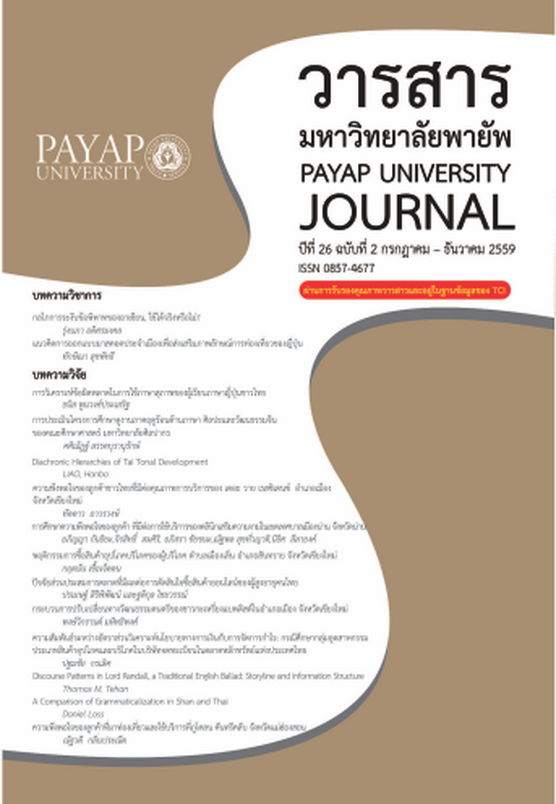Discourse Patterns in Lord Randall, a Traditional English Ballad: Storyline and Information Structure
Main Article Content
Abstract
This paper discusses selected discourse patterns in the English ballad Lord Randall (LR). From a discourse analysis perspective, there are lots of words and so little narrative information so the natural question is: “How does the listener follow the storyline” This paper is an inquiry into how the information is patterned in relating the storyline events in the eight stanzas of closed conversation in this ballad. After a quick survey of the ballad’s structure, the storyline, the information structure, participant reference and the Peak of the ballad are described. Rather than following Longacre’s typical English storyline schema (e.g. Longacre 1996:24-26 ), in this ballad the listeners must infer and build their own sequential line of events from questions and answers in a dialogue between LR and his mother. The traditional English simple past tense is only marginally helpful in constructing the ballad’s storyline. The repetitious stanza (and information) structure is an indicator of where the audience must find its clues of new information in building the storyline. The break in information pattern at the Peak is a signal that the information crucial to constructing a coherent narrative is concentrated at the end of stanza seven. This ballad is another example of how the discourse analyst must look beyond a typical canonical storyline to arrange the sequential events of this narrative.
Article Details
References
Bequette, Rebecca Lee Elaine. (2008). Participant reference, deixis, and anaphora in Bunong narrative discourse. MA thesis. Dallas: Graduate Institute of Applied Linguistics.
Glossary of linguistic terms, by Eugene E. Loos (general editor), Susan Anderson (editor), Dwight H., Day, Jr. (editor), Paul C. Jordan (editor), and J. Douglas Wingate (editor). Dallas: SIL International. http://www-01.sil.org/linguistics/GlossaryOflinguisticTerms/ accessed 11 November 2015.
Hwang, Shin Ja Joo. (2010). The development of textlinguistics in the writings of Robert Longacre. Dallas: SIL International.
Johnstone, Barbara. (2002). Discourse Analysis. Oxford, UK: Blackwell Publishers, Ltd. 2nd edition 2008.
Longacre, Robert E. (1981). A spectrum and profile approach to discourse analysis. Text 1.4. 337-359. [reprinted in Hwang 2010].
Longacre, Robert E. (1989). Joseph, as story of divine providence: A text theoretical and textlinguistic analysis of Genesis 37 and 39-48. Winona Lake, IN: Eisenbrauns.
Longacre, Robert E. (1996). The grammar of discourse. 2nd Edition. Texas: SIL.
Longacre, Robert E. (2000). Some hermeneutic observations on textlinguistics and text theory in the humanities. In David G. Lockwood, Peter H. Fries and James E. Copeland (eds.), Functional approaches to language, culture and cognition, 169-83. Current Issues in Linguistic Theory, 163. Amsterdam: John Benjamins Publishing Company. [can be found in Hwang, Shin Ja Joo. 2010. The development of textlinguistics in the writings of Robert Longacre. Dallas: SIL International.]
Merriam, Alan P. (1964). Chapter X: The study of song texts. The anthropology of music. Evanston, IL: Northwestern University Press.
Nattiez, Jean-Jacques. (1990). Music and Discourse: Toward a Semiology of Music. Princeton: Princeton University Press. Carolyn Abbate, trans.
Somsonge Burusphat. (1991). The structure of Thai narrative. Dallas, TX: SIL-UTA.

